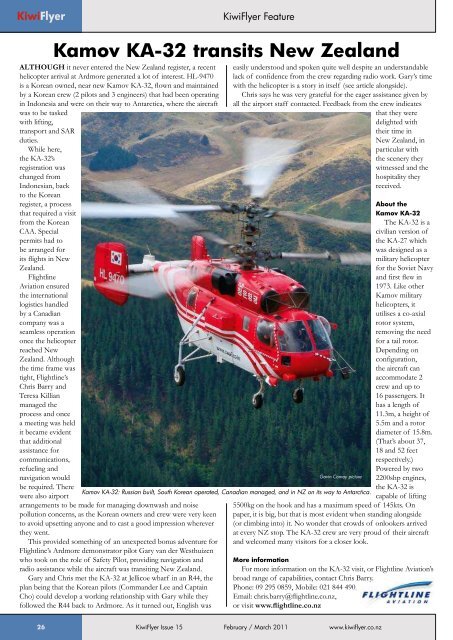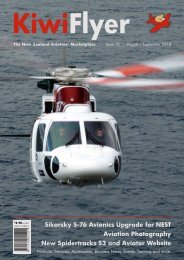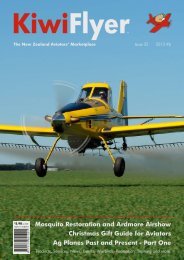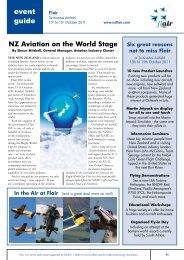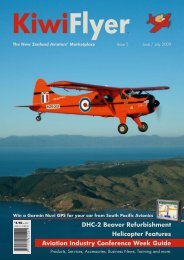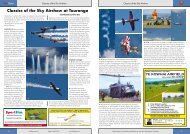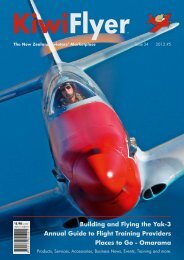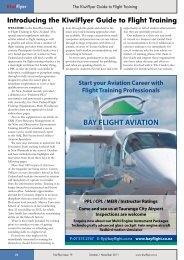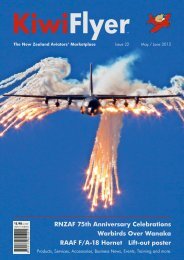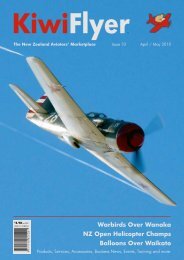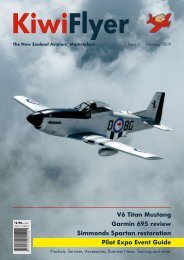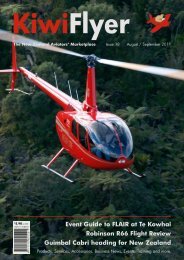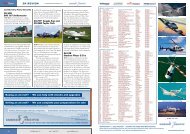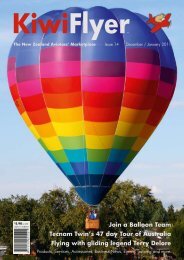Download Issue 15 complete - KiwiFlyer
Download Issue 15 complete - KiwiFlyer
Download Issue 15 complete - KiwiFlyer
Create successful ePaper yourself
Turn your PDF publications into a flip-book with our unique Google optimized e-Paper software.
<strong>KiwiFlyer</strong> <strong>KiwiFlyer</strong> Feature <strong>KiwiFlyer</strong> Feature<br />
Kamov KA-32 transits New Zealand<br />
ALTHOUGH it never entered the New Zealand register, a recent<br />
helicopter arrival at Ardmore generated a lot of interest. HL-9470<br />
is a Korean owned, near new Kamov KA-32, flown and maintained<br />
by a Korean crew (2 pilots and 3 engineers) that had been operating<br />
in Indonesia and were on their way to Antarctica, where the aircraft<br />
was to be tasked<br />
with lifting,<br />
transport and SAR<br />
duties.<br />
While here,<br />
the KA-32’s<br />
registration was<br />
changed from<br />
Indonesian, back<br />
to the Korean<br />
register, a process<br />
that required a visit<br />
from the Korean<br />
CAA. Special<br />
permits had to<br />
be arranged for<br />
its flights in New<br />
Zealand.<br />
Flightline<br />
Aviation ensured<br />
the international<br />
logistics handled<br />
by a Canadian<br />
company was a<br />
seamless operation<br />
once the helicopter<br />
reached New<br />
Zealand. Although<br />
the time frame was<br />
tight, Flightline’s<br />
Chris Barry and<br />
Teresa Killian<br />
managed the<br />
process and once<br />
a meeting was held<br />
it became evident<br />
that additional<br />
assistance for<br />
communications,<br />
refueling and<br />
navigation would<br />
be required. There<br />
were also airport<br />
arrangements to be made for managing downwash and noise<br />
pollution concerns, as the Korean owners and crew were very keen<br />
to avoid upsetting anyone and to cast a good impression wherever<br />
they went.<br />
This provided something of an unexpected bonus adventure for<br />
Flightline’s Ardmore demonstrator pilot Gary van der Westhuizen<br />
who took on the role of Safety Pilot, providing navigation and<br />
radio assistance while the aircraft was transiting New Zealand.<br />
Gary and Chris met the KA-32 at Jellicoe wharf in an R44, the<br />
plan being that the Korean pilots (Commander Lee and Captain<br />
Cho) could develop a working relationship with Gary while they<br />
followed the R44 back to Ardmore. As it turned out, English was<br />
easily understood and spoken quite well despite an understandable<br />
lack of confidence from the crew regarding radio work. Gary’s time<br />
with the helicopter is a story in itself (see article alongside).<br />
Chris says he was very grateful for the eager assistance given by<br />
all the airport staff contacted. Feedback from the crew indicates<br />
that they were<br />
delighted with<br />
their time in<br />
New Zealand, in<br />
particular with<br />
the scenery they<br />
witnessed and the<br />
hospitality they<br />
received.<br />
About the<br />
Kamov KA-32<br />
The KA-32 is a<br />
civilian version of<br />
the KA-27 which<br />
was designed as a<br />
military helicopter<br />
for the Soviet Navy<br />
and first flew in<br />
1973. Like other<br />
Kamov military<br />
helicopters, it<br />
utilises a co-axial<br />
rotor system,<br />
removing the need<br />
for a tail rotor.<br />
Depending on<br />
configuration,<br />
the aircraft can<br />
accommodate 2<br />
crew and up to<br />
16 passengers. It<br />
has a length of<br />
11.3m, a height of<br />
5.5m and a rotor<br />
diameter of <strong>15</strong>.8m.<br />
(That’s about 37,<br />
18 and 52 feet<br />
respectively.)<br />
Powered by two<br />
Gavin Conroy picture 2200shp engines,<br />
the KA-32 is<br />
capable of lifting<br />
5500kg on the hook and has a maximum speed of 145kts. On<br />
paper, it is big, but that is most evident when standing alongside<br />
(or climbing into) it. No wonder that crowds of onlookers arrived<br />
at every NZ stop. The KA-32 crew are very proud of their aircraft<br />
and welcomed many visitors for a closer look.<br />
Kamov KA-32: Russian built, South Korean operated, Canadian managed, and in NZ on its way to Antarctica.<br />
More information<br />
For more information on the KA-32 visit, or Flightline Aviation’s<br />
broad range of capabilities, contact Chris Barry.<br />
Phone: 09 295 0859, Mobile: 021 844 490,<br />
Email: chris.barry@flightline.co.nz,<br />
or visit www.flightline.co.nz<br />
Not a normal day at the office Contributed by Gary van der Westhuizen<br />
Gary van der Westhuizen is a B-Cat Instructor at<br />
Ardmore Helicopters and recently picked up the role of<br />
Demonstrator Pilot for Flightline Aviation, based just<br />
across the field. He never thought that would lead to<br />
becoming a Co-Pilot on a Kamov KA-32. Gary writes<br />
of his role in the KA-32’s NZ transit as follows:<br />
WITH A combination of broken English,<br />
hand signals and an R44 leading the way, we<br />
made our way to Ardmore from the Port of<br />
Auckland with not too much difficulty, and<br />
were welcomed by a small crowd with almost<br />
everyone taking photos. In fact we had quite a<br />
few spectators at every stop we made. I suppose<br />
it’s not every day that a Russian built helicopter,<br />
with a Korean crew is navigated by a South<br />
African making radio calls in New Zealand. It’s<br />
what you might call a communication adventure.<br />
After a few days of paperwork and after test<br />
flying with the Korean CAA, we planned to<br />
make our way to Christchurch via Palmerston<br />
North and Woodbourne. From Christchurch,<br />
the helicopter would fly to Lyttelton and then<br />
sail for Antarctica to assist research teams with<br />
transport and Search and Rescue operations. We<br />
needed to make a few stops due to the thirsty<br />
nature of this machine, burning about 800 litres<br />
per hour. Each of the two engines produces<br />
2200 shp, allowing us to cruise at 130 knots<br />
which was surprising for a helicopter with an<br />
AUW of 11000 kg.<br />
How it Works<br />
The controls work the same as they do in<br />
any other helicopter, but with a small difference.<br />
There is a button on the cyclic that you push,<br />
as you also pull a lever attached to the collective<br />
while sitting in the hover. This activates the<br />
hydraulic system and makes the controls feel<br />
slightly heavier compared to the way they feel in<br />
an R44 for example.<br />
To move into forward flight once you have<br />
selected your power setting, you release the<br />
lever on the collective (which locks it in place)<br />
and then release the button on the cyclic when<br />
you reach your desired speed (to keep it in<br />
that position). There is still some movement<br />
available in both controls if small adjustments<br />
are needed.<br />
The pedals work the same way as normal, but<br />
are just a little less effective than a helicopter<br />
with a tail rotor. Yaw is achieved by increasing<br />
the pitch on one rotor and decreasing it on the<br />
other, thereby producing more torque in one<br />
direction. The pedals also move the big vertical<br />
stabilisers which can be adjusted to make sure<br />
you stay in balance.<br />
So manoeuvring the helicopter is not that<br />
difficult - you just have to get used to sitting a<br />
lot higher than you normally would in the hover.<br />
This is because you’re already about six feet off<br />
the ground before the helicopter has left it.<br />
The Trip South<br />
The Korean crew were amazed with our<br />
New Zealand scenery, taking pictures and video<br />
as we made our way down the country. I don’t<br />
blame them - I’m still amazed at how beautiful<br />
this country is. We had some good weather on<br />
the way and the trip was heaps of fun, though<br />
we did encounter some slightly less desirable<br />
weather as we got closer to Woodbourne. We<br />
tracked down the east coast to Christchurch<br />
where after just over five hours of flying we<br />
made our final landing. Thanks to HeliPro who<br />
kindly made a suitable spot available for us to<br />
land. We shook hands and said our farewells<br />
to go our separate ways, since I had a flight to<br />
catch back to Auckland. That flight back took<br />
just over an hour on the big plane, but when I<br />
think about it I would much rather have the five<br />
hour adventure again than a one hour nap.<br />
A big thanks to the entire crew of the<br />
Kamov - it was an honour to fly with<br />
you. Thanks to the Air Traffic Controllers<br />
at Palmerston North, Woodbourne and<br />
Christchurch who really made the trip go<br />
smoothly and gave a helping hand wherever they<br />
could. Also to the ground crews who made sure<br />
we landed in the right spot, to the Fuel Tanker<br />
guys who kept our tanks full, and to everyone at<br />
Flightline who helped make the day possible.<br />
What a trip!<br />
Greg Quinn<br />
3 Engineers go to work each time the aircraft<br />
stops. Note the scale of the rotorhead.<br />
Chris Barry (left) and Gary at Ardmore.<br />
Co-axial rotorhead componentry. It didn’t take long to draw a crowd at each stop on the way. KA-32 cockpit, pilot side on the left.<br />
26 <strong>KiwiFlyer</strong> <strong>Issue</strong> <strong>15</strong> February / March 2011 www.kiwiflyer.co.nz Would you like to see a profile on your business in <strong>KiwiFlyer</strong>? Call us on 0800 535937 to discuss options. 27<br />
Greg Quinn


